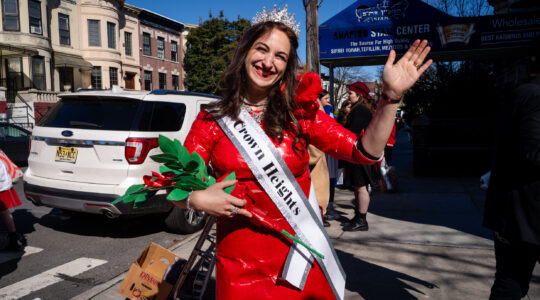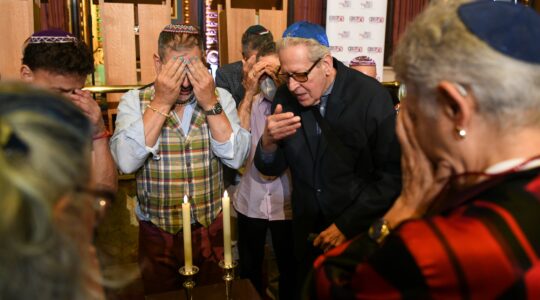When I was a child, the Jewish holidays burst upon my days with no discernible pattern or connection. In St. Louis, as a young girl, I am a Megillah, parading around United Hebrew Temple, my skinny 9-year-old self sandwiched between two yellow poster boards with “The Story of Queen Esther” glued and glittered on the front. And then, some weeks later, returning home from services with my mom and my sister — dad was at work — we ate our Passover feast: crunchy sheaves of matzah slathered with cream cheese and Welch’s grape jelly. There was no hint of what I know now: that the holiday of masking reveals a redeemed world, Purim to Pesach as an expansion and a finer version of freedom.
Now, somewhere past 50, I crave a coherent life. So the idea that the holidays of the Jewish calendar form a unified pattern, offer a vision that can guide and sustain us, has become increasingly important to me. The genius of the system allows us to experience, more fully, the profound patterns of the earth — it weaves elements of nature and history that uncover spiritual landscapes within.
Long ago, the ancients believed that if we celebrated nature’s cycle, it was more likely to continue. We know better now. Or do we? These things don’t depend on us, and yet, we’re also, lately, discovering the profound ways our attention as stewards of the earth has lapsed. And we live, especially in New York City, cut off from nature and her wisdom, sometimes starving for it. The calendar, its graceful move from season to season, its rhythms, is something we need now more than ever. Here then, a walk through the year, in season.
Just when the winter feels as if it will never give way, the crocuses bloom. A fine, barely green fuzz is discernible if I stare really hard at the maple growing alone in my brick-crowded courtyard. Time for liberation, a beginning of another kind.
Our family, the second night of Pesach, sits by the sea. We tell the Exodus story to the sound of the waves in Miami Beach. The blue-haired ladies on the boardwalk have gone home. Only our voices, speaking of Miriam, speaking of Moses. It is easy to imagine the hooves of the Egyptians beneath the swell of the waves. Later, crammed into a small apartment dining room with another family, we will share charoset and maror sandwiches, a crazy mix —cinnamon scented Manischewitz wine and horseradish — all of it hand-chopped by the children earlier that day. We break matzahs, and the children, who are children no longer, find the broken pieces. We need the playfulness of children to show us how to retrieve the broken parts of ourselves. Another layer of the self lost and found. Another year.
Next, we count our way — 49 days — to the revelation at Sinai. Our ancestors counted, too, wondering if the wheat crop would flourish, if the trees would bear fruit. On Shavuot, I love to stay up into the night studying, honoring the revelations past and present, the prisms of the Torah that help us to see our lives anew.
In the next season, though, summer, there are no holidays to ride on and it’s a dry time for my Jewish psyche. In the Middle East, where these ideas were born, Av is the driest month. And I am least a Jew in our version, August, which finds me on the shores of Cape Cod, with all the other sunbathers.
There is Tisha b’Av, of course, a tragic day historically, and so we fast. Our Jewish fear of annihilation rears its ugly head on this day. One year, I am in Jerusalem for Tisha b’Av, sitting at midnight, belly empty, among enormous boulders strewn on the still-being-excavated area to the right of the Western Wall. Our rabbi guide has paid off a guard so that we, a coed, non-sanctioned group, might have our own little service in the Temple’s shadows. We sit with flashlights illuminating the woeful phrases of Lamentations, as a mighty wind whips between the boulders, carrying the notes of the muezzin above us, mixing in with our song, and somewhere to the left, the wailing of Orthodox men.
Like a teenager, I kick and stomp my way towards a Rosh HaShanah that almost always arrives too soon. But the intention, at least, is that on the cusp of Elul, we begin our turning. For our ancestors, the entire month was one of rethinking, studying and self-reflection, leading toward the Days of Awe. Elul is 30 days long, and Yom Kippur is the 10th day of Tishrei. Forty days. The time echoes the 40 days of repentance Moses spent on Sinai, after his own somewhat adolescent outburst — when he saw the shining calf and smashed that first set of tablets.
The shofar blasts every morning of Elul, calling to wrest us from our complacency, and sometimes, I do awaken, but mostly for me it’s the lists for Fischer Brothers Butchers and the Silver Moon challah order that signal the holiday’s true beginning. Far from the land and the plow, it’s the bags from Fairway — bright stalks of broccoli, leafy-topped bunches of carrots, apples not yet laden with honey, or baked, soon, into a pie whose aroma seeps through the apartment every year and tells me it’s time for the turning.
Ten days later, after innumerable gatherings of family, friends, food, I am almost ready to enter into the mystery, into the Godspace that’s been created of our prayer, song and communal yearning.
Yom Kippur is the one moment when the High Priest entered the Holy of Holies in the ancient Temple in Jerusalem. A shedding of self inevitably happens each year — all those hours of fasting — and then, a rebirth of sorts that, for me, makes the rest of life seem again possible. The great wheel has begun to spin. At Second Temple times, on the eve of Yom Kippur, buoyed by the shift from solemnity to joy, young unmarried men and women went into the fields to dance and to choose spouses for themselves. Can you imagine that kind of opening — pure potential — public and private spheres wedded, heart, spirit and body aligned?
Then, quick on the heels of Yom Kippur comes Sukkot, my favorite holiday. When I lived in the suburbs, I always loved that moment, leaves falling, ice-tinged air, and all the neighbors sweeping decks and hauling the lawn furniture into the garage. My crazy Jewish friends and I were doing just the opposite. Frigid winds moving in, and we were building a flimsy structure, a booth, to hold us in the night. Time for “Moosewood” gypsy soup, with its chunks of sweet potato, yellow pepper and peas swimming in a broth of turmeric, basil and tomato. It’s harvest time, a gathering in of our resources, bountiful and limited. We are called to recognize an infinite Source, great Gatherer of us all. We do this wrapped in the scent of overhanging pines, and far off there, beyond the cranberry tinsel, the gleam of stars.
Finally, Shemini Atzeret, the barely visible festival we linger in, a harbinger of the rainy winter. A time of inwardness, contraction, starting over once more, this holiday marks the historical moment when our wilderness sojourn ended. We pray for rain now, though we know we’ll have to fight for a city cab or wrestle cheap umbrellas. Still, somewhere, the rains are nourishing new life, growing asparagus and strawberries. Circling.
Moving closer to the winter solstice, the sun’s light barely penetrating the vertical plains of New York’s Upper West Side, I am a creature in shadow, feeling the tug of despair. A Talmudic midrash tells of Adam, witnessing the shortening days and crying, “Woe is me! Perhaps because I sinned the world is growing darker because of me, and is returning to chaos and confusion.” This kind of inner darkness, archetypal, is answered by the rabbis with yet another holiday, another ceremony. Now we light candles, acknowledging we’re in dialogue with the unknown, and yet trusting that the radiance will grow. I have come to appreciate the wisdom of a tradition that demands joy and gladness in the darkest, coldest times.
And if we need more, if our thick skulls haven’t attuned to the world’s constant and ever-changing circling creation/destruction/creation again and again, there is Tu b’Shvat, a whole seder ritual of nuts and dried fruits. We slowly watch the wine glass transform from white to pink to red, perhaps evoking the paleness of winter, an awakening spring and autumn splendor.
Far underground, the roots of the trees are soaking up moisture, making hidden connections, and above, bare branches reach toward an increasing light. The change is nuanced, subtle, hidden, but the mystics of Safed saw the 15th of Shvat as the date on which the Tree of Life renews the flow of life to the universe. We say blessings over figs, dates, olives, pomegranates and plums, releasing holy sparks.
The Jewish calendar has become my compass. Like spokes on a wheel, holiday to holiday, I move through it, live its rising and falling moments. I live far from the land where these ideas were born, where the ancients once poured water libations on the altar at Sukkot, praying for rain. I have four plants on my windowsill, and citified now, I long for a garden. The earth, the lessons of her seasons, calls to me, whispering secrets of life, death and rebirth, the waiting moments — cultivating a patience I’ve never had — the slow promise of unseen growing things.
Shelly R. Fredman teaches writing at Barnard College and at the Writer’s Beit Midrash at Skirball Center for Adult Jewish Learning. Her work has appeared in a number of journals and anthologies. She welcomes students to Skirball who are interested in exploring the meeting places between text and life.
The New York Jewish Week brings you the stories behind the headlines, keeping you connected to Jewish life in New York. Help sustain the reporting you trust by donating today.




